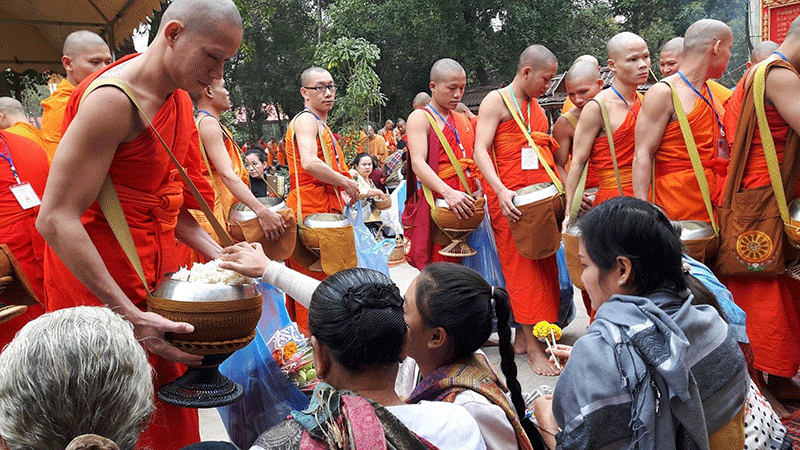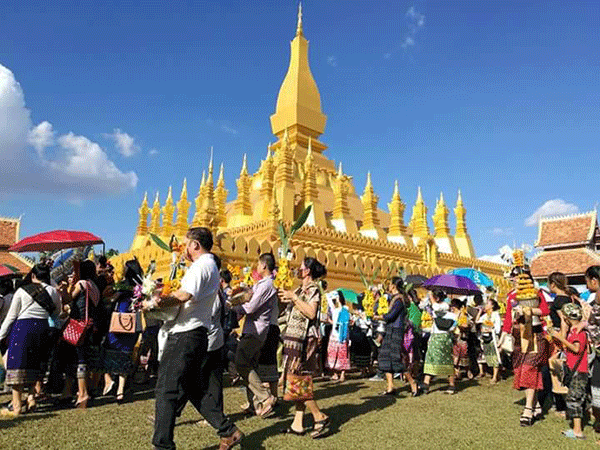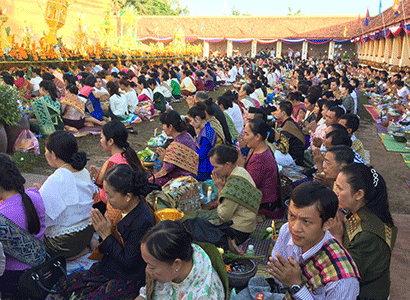 |
| A spot for early morning alms-giving on the last day of the festival. |
It’s time to pay respect to That Luang
The That Luang Festival is a vibrant traditional ritual that holds deep significance for Lao Buddhists. For centuries, this festival has been a time for honouring the Grand Stupa, an important symbol of spiritual devotion.
 |
| The wax castle procession at That Luang. |
The That Luang stupa or Grand Stupa festival is held annually at the beginning of November, the festival takes place after the Buddhist Lent Festival and Boat Racing festival in Vientiane. This year, the festivities will begin from November 11 to 15, as announced by the organising committee during a recent press conference.
The Director of Vientiane Information, Culture, and Tourism, Ms Viengphon Keokhounsy, stated that the festivities will span five days.
Activities include traditional rituals, a wax castle procession, almsgiving, a candlelight procession, and Tikhy (Lao-style hockey) – all beloved events from previous years.
The wax castle procession will take place on November 14 at 1.30 pm which will begin from Simeuang temple to That Luang esplanade. The participants will dress in traditional costumes, eagerly making their way to the esplanade, carrying offerings and Markbeng (banana leaf wrap up with flowers).
The final day of the festival, November 15, will feature almsgiving at 7 am.
In addition to these activities, the Vientiane Industry and Commerce Department is preparing over 1,600 booths for companies, international organisations, SMEs, and local vendors who wish to showcase and sell their products at the That Luang esplanade.
The “One District, One Product” initiative will feature contributions from Vientiane and other provinces.
This year, the organising committee hopes to see an increase in foreign visitors, especially since 2024 has been designated as the “Visit Laos Year.” Last year, over 2,300 foreign tourists attended the festival daily, and this year they expect at least 1,500 foreign visitors to participate in the events.
The That Luang Festival is a significant national event where Lao Buddhists pay homage to the Grand Stupa and reflect on the ancient artifacts on display.
 |
| Buddhists and visitors attend an early morning religious ceremony to give alms and present offerings at That Luang festival. (File Photos) |
Originally built during the ancient Khmer civilisation, the That Luang was first erected as a four-sided stone obelisk by the Cham people.
According to the book “That Luang Viengchanh” published in 1999, the stupa was intended as a place of worship and prayer.
During the reign of King Xaysetthathirath in the 16th century, the original obelisk was encased in a larger stupa, leading to the monument’s current name, That Luang, or Grand Stupa.
This period marked the second wave of Buddhism in Laos, when, under Emperor Ashoka of India, monks brought a relic believed to be a part of the pelvic bone of Lord Buddha to Vientiane in 218 BC. This relic was stored in the obelisk at Phou Luang Hill.
The local ruler at the time, Lord Chanthabouly Phasitthisack, constructed a stupa over the obelisk in 236 BC, naming the holy site Pha Chedi Lokachulamany. According to the legend of “Tamnan Oulangkhathat” Emperor Ashoka ordered that the relics be placed inside the That Luang stupa.
This tale holds that the remains of Lord Buddha were distributed across the globe to Buddhist followers, with his ashes enshrined in 84,000 stupas. Physical evidence from the reign of King Jayavarman VII, dating between the 9th and 14th centuries, confirms that the original obelisk was indeed an ancient Cham construction. Numerous artifacts have been discovered at the site, including a statue of King Jayavarman VII, dating from AD 1181 to 1219, which is currently displayed at the northern end of the inner cloister (Kommalien) alongside the Buddha images.
The history of That Luang has only become clear since the early 16th century, regarded by historians as the midpoint of the ancient Lao period. In AD 1566, King Xaysetthathirath commissioned the construction of the current stupa, six years after making Vientiane the capital of Laos.
In 2016, the government renovated the That Luang stupa by adding a gold finish to its top and expanding the surrounding area, which now spans over 12 hectares.
The site features new parks, roads, entranceways, and gates, including a newly constructed road from the That Luang Market side, which is now bordered by a new fence.
At the festival, men and women are encouraged to wear modest clothing when visiting this sacred site; women typically don long skirts (sinh) when worshiping at the Grand Stupa. Visitors arrive in trousers, skirts are available for rental. Notably, all worshipers must remove their shoes upon entering the site.
Additionally, Lao attendees often wear a sash when entering a temple or stupa and sit cross-legged on the ground as a sign of respect.
Visitors to That Luang can enjoy a variety of sights, even outside of festival times. Tourists often linger to capture photographs of the many stunning buildings surrounding the Grand Stupa, including the Hor Thammasapha, Vat That Luang-Tai, Vat That Luang-Neua, and the Naga’s House. The spacious and inviting area around That Luang offers breathtaking views of these picturesque structures.
The almsgiving ceremony on the final day, held in the early morning, is a significant highlight of the That Luang Festival. After giving alms and presenting offerings, devotees gather to share traditional dishes such as noodle soup, chicken soup, and grilled chicken — foods that have been part of Lao culture for generations.
If this is your first time attending the festival, there’s no need to worry about breakfast after the almsgiving; ample traditional food options are available.
In the afternoon of the same day, attendees can participate in various activities, including a game of Lao-style hockey (Tikhy). The festival culminates in the evening with a colorful candlelight procession, bringing the vibrant celebrations to a close.
By Phon Thikeo
(Latest Update November 11, 2024)
|




